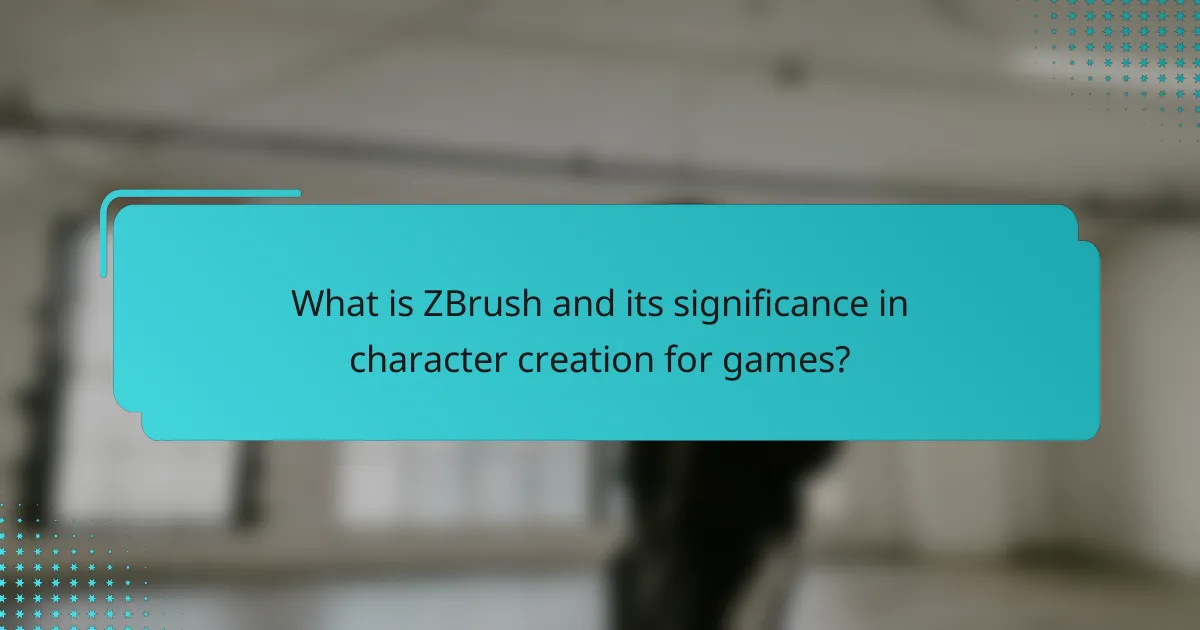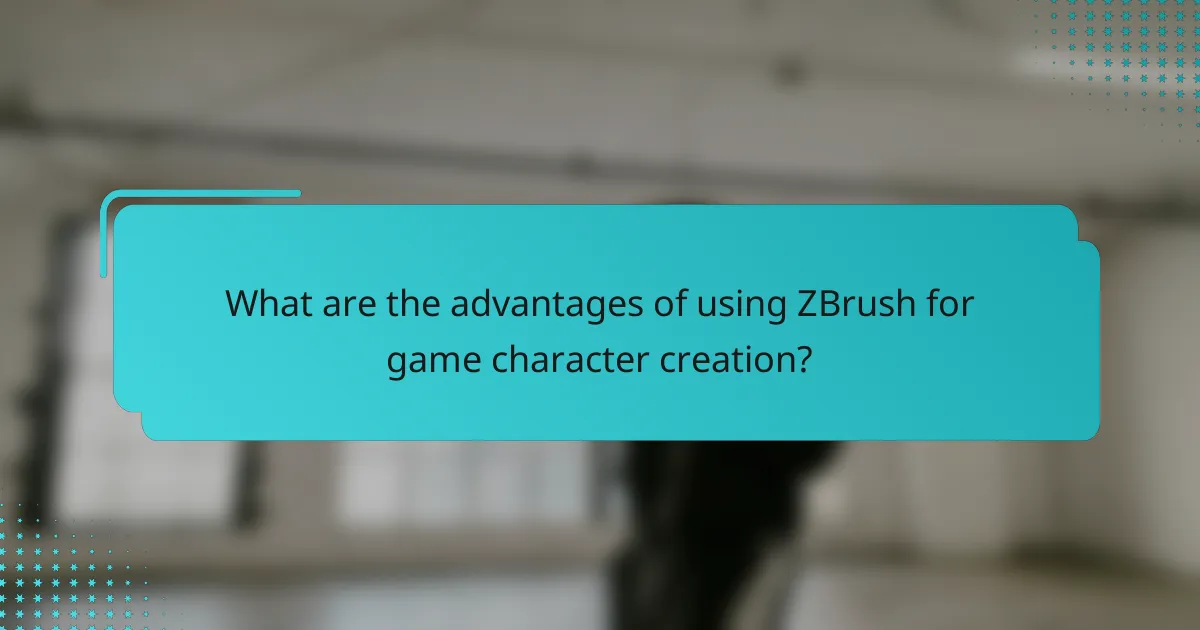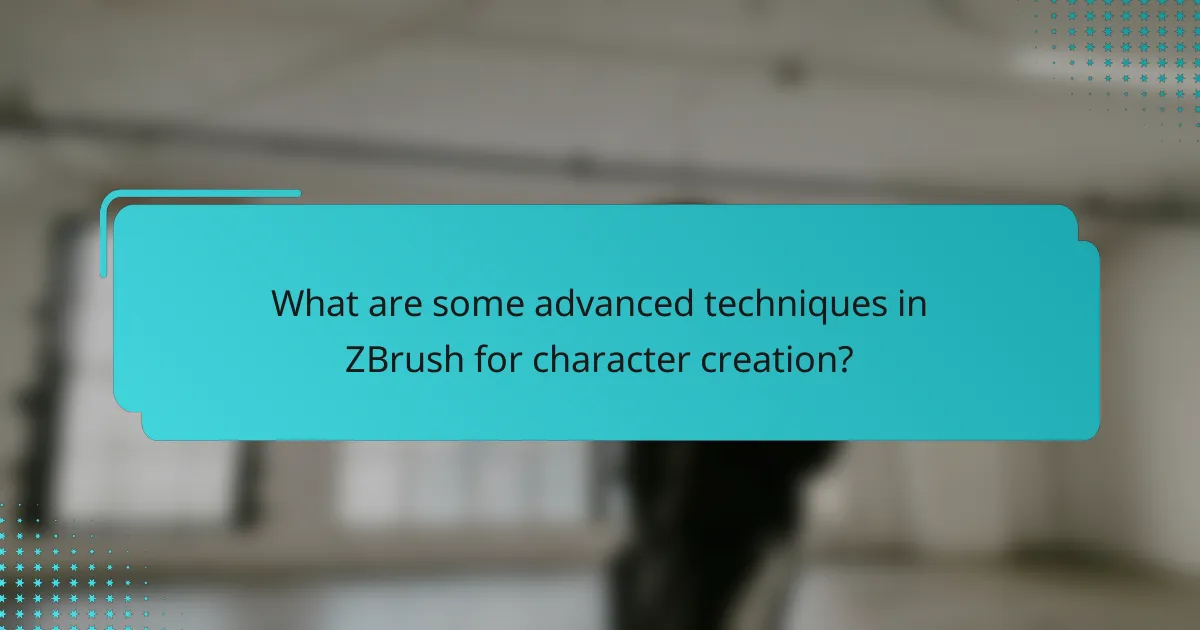
What is ZBrush and its significance in character creation for games?
ZBrush is a digital sculpting tool that combines 3D/2.5D modeling, texturing, and painting. It enables artists to create highly detailed characters and environments for games. ZBrush uses a unique approach called “pixol” technology, which stores data about depth, color, and material information. This allows for intricate surface details and complex textures. Its significance lies in its ability to produce high-resolution models efficiently. Many game developers rely on ZBrush for character creation because of its versatility and user-friendly interface. The software has become a standard in the industry, influencing character design and workflow.
How does ZBrush differ from other 3D sculpting tools?
ZBrush differs from other 3D sculpting tools primarily through its unique approach to digital sculpting. It utilizes a proprietary technology called Pixol, which captures depth, color, and material information in a single pixel. This allows for high-resolution detailing without the constraints of traditional polygon modeling. ZBrush supports millions of polygons, enabling intricate details that other tools may struggle with. Its dynamic subdivision feature allows artists to work on models at various levels of detail seamlessly. Additionally, ZBrush offers advanced brush customization and a variety of sculpting techniques, such as DynaMesh and ZRemesher, which enhance workflow efficiency. These features collectively make ZBrush a preferred choice for character creation in the gaming industry.
What unique features does ZBrush offer for sculpting?
ZBrush offers several unique features for sculpting. One of its standout tools is Dynamesh, which allows artists to create complex shapes without worrying about polygon density. This feature enables seamless merging and manipulation of geometry. Another unique aspect is ZSpheres, which facilitate the creation of base meshes quickly. Artists can easily pose and manipulate these ZSpheres to form a skeletal structure.
Additionally, ZBrush includes advanced detailing tools like Spotlight and Polygroups. Spotlight allows for projecting images onto the surface for precise detailing. Polygroups enable artists to manage different areas of a model efficiently. The software also features unique brushes, such as the TrimDynamic and ClayBuildup brushes, which enhance the sculpting process.
These tools collectively provide an innovative and flexible sculpting environment. ZBrush’s capabilities have made it a leading choice in the game design industry for character creation.
How does ZBrush enhance the workflow of game developers?
ZBrush enhances the workflow of game developers by providing advanced sculpting tools. These tools allow for high-resolution detailing that is crucial for character creation. Developers can create complex textures and intricate designs efficiently. ZBrush supports a non-destructive workflow, enabling artists to make changes without losing previous work. The software features powerful brushes that mimic real-world sculpting techniques. This versatility allows artists to experiment freely and innovate. Additionally, ZBrush integrates seamlessly with other software, improving collaboration within development teams. Its adaptive skinning and retopology features streamline the modeling process. Overall, ZBrush significantly reduces the time needed to produce high-quality game assets.
What are the core sculpting techniques available in ZBrush?
The core sculpting techniques available in ZBrush include Dynamesh, ZRemesher, and Sculptris Pro. Dynamesh allows artists to create a uniform mesh by redistributing polygons as they sculpt. This technique enables seamless modifications and complex shapes without worrying about topology. ZRemesher is used for retopologizing a model automatically, resulting in a clean and manageable mesh. It preserves the original shape while optimizing the polygon count. Sculptris Pro provides dynamic tessellation, allowing artists to add detail where needed without affecting the entire model. This technique enhances workflow efficiency by focusing on specific areas during the sculpting process. Each of these techniques plays a crucial role in character creation within ZBrush, offering flexibility and control to artists.
How can the Dynamesh feature be utilized in character sculpting?
The Dynamesh feature can be utilized in character sculpting to create a seamless and unified mesh. It enables artists to freely manipulate and sculpt forms without worrying about polygon distribution. When Dynamesh is activated, it automatically redistributes polygons based on the sculpting changes made. This allows for the preservation of volume and detail while adding or subtracting from the model. Artists can quickly iterate on designs, making it easier to refine shapes and proportions. The feature is particularly useful for creating complex organic forms, as it eliminates the constraints of traditional topology. Additionally, Dynamesh facilitates easy merging of separate sculpted parts into a single cohesive model. This versatility enhances the creative process in character design, allowing for more experimentation and fluidity in sculpting.
What role does ZSpheres play in character design?
ZSpheres are a modeling tool in ZBrush that facilitate character design. They allow artists to create a base mesh quickly and intuitively. ZSpheres can be manipulated to form the basic structure of a character. This method supports organic modeling, making it easier to visualize anatomy. Artists can adjust proportions and poses in real-time. The ZSpheres system provides a flexible workflow, enabling rapid iterations. It also allows for easy conversion to a polygonal mesh. This feature enhances the overall efficiency of the character design process.
How can artists leverage ZBrush for game character details?
Artists can leverage ZBrush for game character details by utilizing its advanced sculpting tools. ZBrush offers features like Dynamesh, which allows for seamless mesh manipulation. Artists can create intricate details with its powerful brush system. The software supports high-resolution textures, enhancing character realism. Artists can also use ZBrush’s polygroups to manage complex models efficiently. Additionally, the detailing process can be accelerated through the use of alphas and masks. ZBrush integrates well with other game engines, facilitating smooth workflow transitions. This versatility makes it a preferred tool for character artists in the gaming industry.
What techniques can be used for adding textures and details in ZBrush?
Techniques for adding textures and details in ZBrush include using alphas, polygroups, and displacement maps. Alphas are grayscale images that create depth and detail on surfaces. Polygroups help in organizing different areas for texturing. Displacement maps provide high-resolution detail by altering geometry based on texture data.
Additionally, the use of the Surface Noise feature adds random detail across a model’s surface. The Spotlight tool allows for image projection directly onto the model for precise texturing. Using the ZBrush Paint tool enables artists to paint directly onto the model, enhancing detail. Lastly, the UV Master tool assists in unwrapping models for better texture application. These techniques collectively enhance the visual complexity of character models in game design.
How does the Subdivision Surface feature impact character modeling?
The Subdivision Surface feature significantly enhances character modeling by smoothing out geometry. It allows artists to create more complex shapes without increasing the polygon count excessively. This feature subdivides the mesh, generating additional vertices and faces. As a result, it produces a smoother appearance and more detailed forms. Artists can refine character features with high precision. The technique is widely used in game development for realistic character design. It enables efficient workflows by allowing for non-destructive editing. Many industry-standard software, including ZBrush, utilize this feature to optimize character modeling.

What are the advantages of using ZBrush for game character creation?
ZBrush offers several advantages for game character creation. Its powerful sculpting tools enable high-resolution detailing. Artists can create intricate textures and features that enhance realism. ZBrush supports a non-destructive workflow, allowing for flexible adjustments. This flexibility is crucial during the iterative design process. The software also features advanced poly-painting capabilities, enabling color application directly on models. ZBrush’s ability to handle millions of polygons makes it ideal for complex characters. Additionally, it integrates well with other software in the game development pipeline. These advantages contribute to efficient and high-quality character design.
Why is ZBrush considered the industry standard for character sculpting?
ZBrush is considered the industry standard for character sculpting due to its advanced digital sculpting capabilities. It allows artists to create highly detailed models with millions of polygons. The software features a unique sculpting workflow that combines traditional sculpting techniques with digital tools. ZBrush’s powerful brush engine enables artists to manipulate surfaces in real-time. It also supports dynamic subdivision, allowing for smooth detailing without compromising performance. Many leading game studios and visual effects companies use ZBrush for character design. Its user-friendly interface and extensive customization options enhance productivity. ZBrush has consistently been used in award-winning films and games, solidifying its reputation in the industry.
What unique advantages does ZBrush provide for high-resolution models?
ZBrush provides unique advantages for high-resolution models through its advanced sculpting tools and dynamic subdivision capabilities. The software allows artists to work with millions of polygons, enabling intricate detailing. Its DynaMesh feature facilitates seamless mesh manipulation without topology constraints. ZBrush also offers powerful texturing options, including Polygroups and UV mapping tools. The ability to create and manage high-resolution normal and displacement maps enhances surface detail. Additionally, ZBrush’s non-destructive workflow allows for iterative design changes without losing previous work. These features collectively empower artists to achieve highly detailed and complex character designs efficiently.
How does ZBrush facilitate the creation of stylized versus realistic characters?
ZBrush facilitates the creation of stylized and realistic characters through its advanced sculpting tools and features. The software offers a dynamic brush system that allows artists to manipulate forms with precision. For stylized characters, artists can use custom brushes to create exaggerated features and unique textures. ZBrush’s DynaMesh feature enables seamless topology changes, essential for artistic freedom in stylization.
In contrast, for realistic characters, ZBrush provides detailed sculpting options that capture intricate anatomy and surface details. The software’s Polygroups and Subdivision Levels allow for high-resolution detailing, essential for realism. Additionally, ZBrush’s ability to work with 3D textures enhances the lifelike quality of characters.
The versatility of ZBrush makes it a preferred tool for artists aiming to balance stylization and realism in character design. Its comprehensive toolkit supports various artistic styles, ensuring that artists can achieve their desired outcomes effectively.
What are the best practices for character creation in ZBrush?
The best practices for character creation in ZBrush include starting with a strong base mesh. A well-defined base mesh serves as a foundation for detailed sculpting. Utilize ZBrush’s DynaMesh feature to maintain topology as you sculpt. Regularly use the ZRemesher tool to create clean topology for animation. Employ reference images to ensure accurate proportions and details. Take advantage of the various brushes available for adding texture and detail. Use polygroups to manage different parts of the model effectively. Save your work frequently to prevent data loss. These practices enhance workflow efficiency and result in high-quality character models.
How can artists optimize their workflow in ZBrush?
Artists can optimize their workflow in ZBrush by utilizing customizable user interface settings. Customizing the interface allows artists to access tools quickly. They can create custom palettes for frequently used brushes and tools. Using shortcuts for commands streamlines the sculpting process. Artists should also leverage ZBrush’s subtool management for complex models. This feature allows for efficient organization and editing of multiple components. Additionally, employing the Dynamesh feature enhances modeling flexibility. It enables artists to merge and modify mesh topology seamlessly. Regularly saving incremental versions of work prevents data loss. These strategies collectively improve efficiency in character creation.
What common mistakes should artists avoid when using ZBrush?
Common mistakes artists should avoid when using ZBrush include neglecting proper topology. Poor topology can lead to issues in animation and deformation. Artists often skip the retopology process, resulting in complex geometry that is hard to manage. Another mistake is not utilizing ZBrush’s layers effectively. Layers allow for non-destructive editing, which enhances workflow. Failing to save frequently can lead to loss of work due to crashes. Artists should also avoid over-relying on high-resolution details too early in the process. This can hinder performance and slow down the sculpting workflow. Additionally, ignoring the importance of reference images can lead to unrealistic proportions and details. Lastly, not taking advantage of ZBrush’s tools and features, such as the ZModeler brush, can limit creativity and efficiency.

What are some advanced techniques in ZBrush for character creation?
Advanced techniques in ZBrush for character creation include using Dynamesh for seamless topology updates. This allows artists to sculpt without worrying about polygon distribution. Another technique is ZRemesher, which generates clean, efficient topology automatically. Artists can also utilize the Sculptris Pro feature for dynamic tessellation while sculpting.
Furthermore, the use of Polygroups helps in managing complex models by allowing artists to work on specific areas without affecting others. The Layer system enables non-destructive edits, allowing for experimentation without permanent changes. Additionally, the use of Spotlight for image projection aids in texturing and reference application.
These techniques enhance workflow efficiency and improve the quality of character models. Many industry professionals rely on these methods to create highly detailed and optimized characters for games.
How can artists use ZBrush for creating complex character poses?
Artists can use ZBrush for creating complex character poses by utilizing its advanced sculpting tools and features. ZBrush allows for dynamic posing through its Transpose Master feature. This feature lets artists manipulate multiple subtools simultaneously. Artists can also use the ZSphere rigging system to establish base poses. The interface provides a range of brushes for detailing and refining the pose. Additionally, artists can employ the Poseable Symmetry function for balanced poses. This function ensures both sides of the character mirror each other. ZBrush’s ability to handle high-resolution meshes enhances the detail in complex poses. The software also supports posing with layers, allowing for non-destructive adjustments. These features combined make ZBrush a powerful tool for artists aiming to create intricate character poses.
What role does the Transpose Master play in posing characters?
The Transpose Master in ZBrush is a tool that facilitates the posing of characters. It allows artists to create and manage poses for multiple subtools simultaneously. This capability enhances workflow efficiency and maintains the integrity of the sculpted details. By using Transpose Master, users can pose characters without losing the original mesh quality. This tool also supports the creation of complex poses that would be challenging to achieve otherwise. The functionality is crucial for game character design, where dynamic poses are essential for visual storytelling. Overall, Transpose Master streamlines the posing process in ZBrush, making it a vital resource for character creation in games.
How can ZBrush’s Morph Target feature enhance character animation?
ZBrush’s Morph Target feature enhances character animation by allowing artists to create and store different [censured] expressions and poses. This feature enables the blending of multiple shapes seamlessly. Animators can transition between these shapes to achieve fluid motion. Morph Targets facilitate the creation of realistic character emotions. They provide a way to animate subtle changes in expressions. This results in more lifelike characters in games. The ability to manipulate multiple targets increases artistic flexibility. It allows for detailed customization of animations.
What resources are available for learning ZBrush sculpting techniques?
Online platforms such as Udemy and Coursera offer comprehensive courses on ZBrush sculpting techniques. These courses cover various skill levels, from beginner to advanced. YouTube hosts numerous tutorials created by experienced artists. Websites like ZBrushCentral provide forums and community support for troubleshooting and tips. Books such as “ZBrush Character Creation” by Scott Spencer offer in-depth knowledge and techniques. Additionally, Pixologic, the creators of ZBrush, provide official documentation and tutorials on their website. These resources collectively enhance understanding and mastery of ZBrush sculpting.
Where can artists find tutorials and community support for ZBrush?
Artists can find tutorials and community support for ZBrush on various platforms. Websites like YouTube offer numerous video tutorials covering different aspects of ZBrush. The official ZBrush website also features a resources section with tutorials and documentation. Forums like ZBrushCentral provide a community space for artists to share tips and seek advice. Social media groups on platforms like Facebook and Reddit are also valuable for connecting with other ZBrush users. These resources collectively offer a comprehensive support network for learning and improving ZBrush skills.
What are some recommended courses for mastering ZBrush in game development?
Some recommended courses for mastering ZBrush in game development include “ZBrush Character Sculpting for Games” on Udemy. This course covers essential sculpting techniques and workflows. Another option is “ZBrush for Beginners” on Pluralsight, focusing on the basics of ZBrush. The “Mastering ZBrush” course on Gnomon offers advanced techniques for professional game artists. Additionally, “ZBrush: Hard Surface Modeling” on LinkedIn Learning teaches hard surface techniques applicable in game design. Each course provides practical skills relevant to character creation in games.
What tips can enhance the character creation process in ZBrush?
Utilizing reference images can significantly enhance the character creation process in ZBrush. Reference images provide visual guidance and help maintain anatomical accuracy. They can be imported directly into ZBrush, allowing artists to sculpt with a clear vision. Using the ZBrush ‘Image Plane’ feature enables artists to overlay these references onto their workspace. This technique helps in achieving correct proportions and details. Additionally, employing ZBrush’s ‘Dynamesh’ feature allows for flexible and dynamic sculpting. It lets artists create complex forms without worrying about topology initially. Regularly saving incremental versions of the project ensures that progress is preserved and mistakes can be easily reverted. Finally, experimenting with different brushes can lead to unique textures and details, enhancing the overall character design.
ZBrush is a digital sculpting tool widely used in game character creation, known for its unique pixol technology that captures depth, color, and material information. This article explores ZBrush’s significance, highlighting its advanced sculpting techniques such as Dynamesh, ZRemesher, and Sculptris Pro, which enhance workflow efficiency and detail in character models. Key features like ZSpheres and Transpose Master facilitate the creation of complex shapes and poses, while techniques for texture application and detail enhancement are also discussed. Additionally, the article provides best practices for character creation and resources for learning ZBrush, establishing it as an essential tool in the gaming industry.